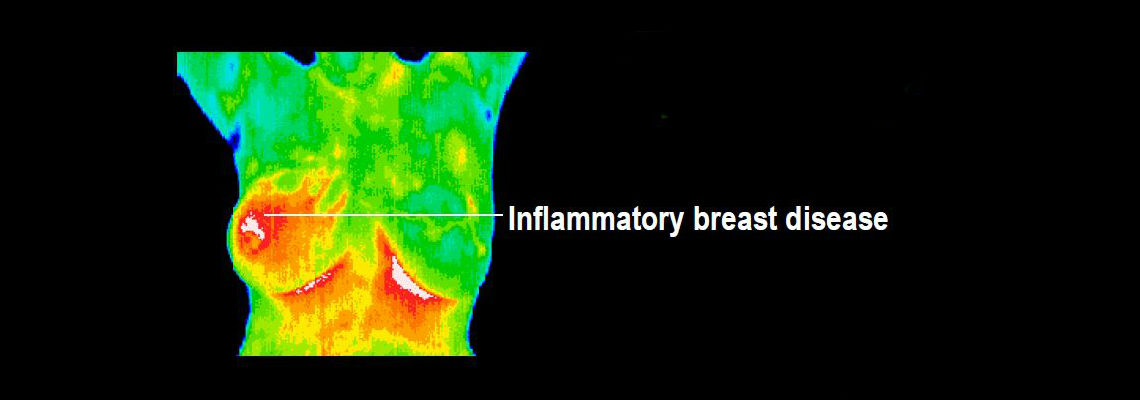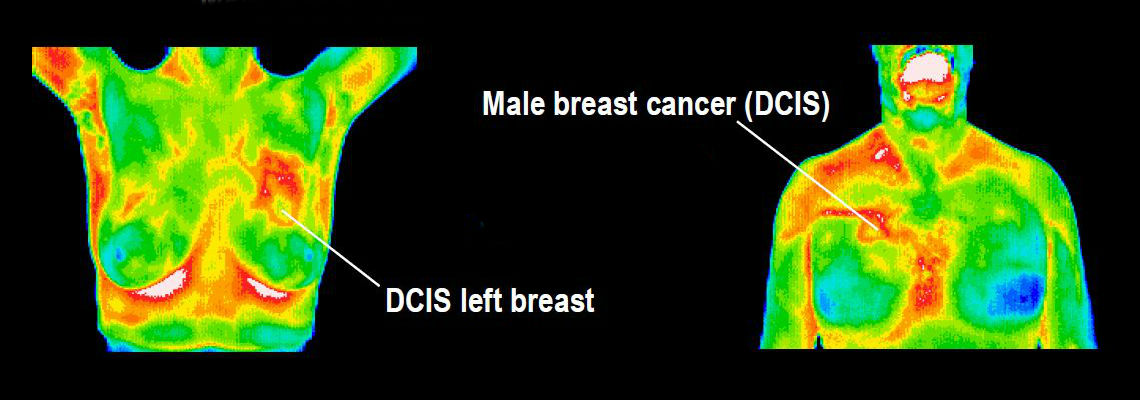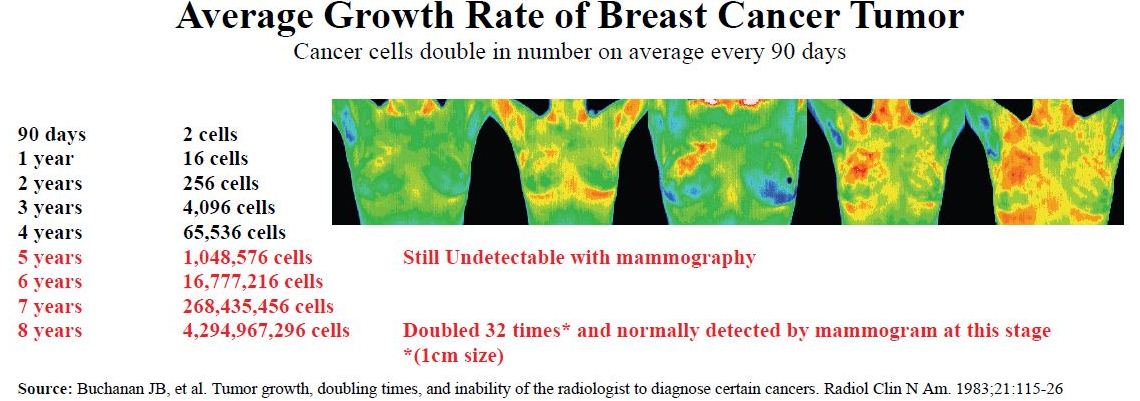 This patient is a 37 year old female whose first baseline thermogram showed a slight hyperthermic asymmetry in the upper right breast. The follow up study showed the pattern had become more well defined & although clinical correlation did not find anything remarkable, it was decided to repeat the exam again in a further 3 months when again significant changes were seen. Mammography was performed at this stage with the thermographic guidance of a locally suspicious area at one o’clock to the right nipple. The mammographic findings were inconclusive and the patient was referred for a repeat mammogram in twelve months. Thermographic monitoring ws continued and at the fifth comparative study at twelve months significant changes were still evident and the hyperthermic asymmetry (temperature differentials) had increased. Immediate further investigation was strongly recommended despite a scheduled mammogram in six months. At the patient’s insistence a repeat mammogram was performed that clearly showed a small 1mm calcification at one o’clock in the right breast. An immediate lumpectomy was performed with good margins and the pathology confirmed as a malignant carcinoma (DCIS). The patient has had stable thermograms for the last two years and is expected to remain healthy.
This patient is a 37 year old female whose first baseline thermogram showed a slight hyperthermic asymmetry in the upper right breast. The follow up study showed the pattern had become more well defined & although clinical correlation did not find anything remarkable, it was decided to repeat the exam again in a further 3 months when again significant changes were seen. Mammography was performed at this stage with the thermographic guidance of a locally suspicious area at one o’clock to the right nipple. The mammographic findings were inconclusive and the patient was referred for a repeat mammogram in twelve months. Thermographic monitoring ws continued and at the fifth comparative study at twelve months significant changes were still evident and the hyperthermic asymmetry (temperature differentials) had increased. Immediate further investigation was strongly recommended despite a scheduled mammogram in six months. At the patient’s insistence a repeat mammogram was performed that clearly showed a small 1mm calcification at one o’clock in the right breast. An immediate lumpectomy was performed with good margins and the pathology confirmed as a malignant carcinoma (DCIS). The patient has had stable thermograms for the last two years and is expected to remain healthy.
 Elderly female patient that had undergone a left hip replacement three months previously. Her continued leg pain raised a suspicion for deep vein thrombosis (DVT). The thermographic findings were not consistent with DVT, but showed a focal area of inflammation that guided a sonographer to a deep abscess near the bone. The abscess was lanced and treated successfully with antibiotics.
Elderly female patient that had undergone a left hip replacement three months previously. Her continued leg pain raised a suspicion for deep vein thrombosis (DVT). The thermographic findings were not consistent with DVT, but showed a focal area of inflammation that guided a sonographer to a deep abscess near the bone. The abscess was lanced and treated successfully with antibiotics.
 Complex Regional Pain Syndrome (CRPS) right foot, significant increase in sympathetic motor tone right foot 3.7°c colder than left foot. A cold stress test was positive, (no sympathetic change). CRPS developed in the right foot after a fractured heel bone 18 months previously. Weight bearing was painful. The diagnosis of CRPS was missed initially since nuclear imaging was not typical of CRPS. Some cases of CRPS are misdiagnosed as psychological or hysterical pain states. Thermography is able to show characteristic changes if utilized.
Complex Regional Pain Syndrome (CRPS) right foot, significant increase in sympathetic motor tone right foot 3.7°c colder than left foot. A cold stress test was positive, (no sympathetic change). CRPS developed in the right foot after a fractured heel bone 18 months previously. Weight bearing was painful. The diagnosis of CRPS was missed initially since nuclear imaging was not typical of CRPS. Some cases of CRPS are misdiagnosed as psychological or hysterical pain states. Thermography is able to show characteristic changes if utilized.
 A 28 year old male carpet layer presented with a clinical left carpal tunnel syndrome, The EMG was normal but the left median sensory nerve latency and amplitude suggested minimal dysfunction relative to the right side. Thermography during sympathetic challenge (cold stress test) showed sympathetic nerve dysfunction consistent with an early left carpal tunnel syndrome. Thermographic sensitivity for detection of early carpal tunnel syndrome is improved by cold stressing both hands. Sympathetic nerve fibers in the symptomatic median nerve are hyper-irritable producing a sustained response during cold stress.
A 28 year old male carpet layer presented with a clinical left carpal tunnel syndrome, The EMG was normal but the left median sensory nerve latency and amplitude suggested minimal dysfunction relative to the right side. Thermography during sympathetic challenge (cold stress test) showed sympathetic nerve dysfunction consistent with an early left carpal tunnel syndrome. Thermographic sensitivity for detection of early carpal tunnel syndrome is improved by cold stressing both hands. Sympathetic nerve fibers in the symptomatic median nerve are hyper-irritable producing a sustained response during cold stress.
 Integrated Progression Flow Chart with DITI as part of a Breast Screening Program
Integrated Progression Flow Chart with DITI as part of a Breast Screening Program
» 119.0 KiB – 3,556 hits – June 26, 2013
 20 Year Followup Study
20 Year Followup Study
» 218.9 KiB – 4,107 hits – June 26, 2013
 Breast Study – Positive comparative study showing changes over one year
Breast Study – Positive comparative study showing changes over one year
» 251.7 KiB – 3,570 hits – June 26, 2013
 Understanding the role of Digital Infrared Thermal Imaging in breast screening
Understanding the role of Digital Infrared Thermal Imaging in breast screening
» 18.4 KiB – 3,705 hits – June 26, 2013






